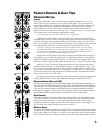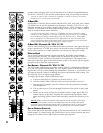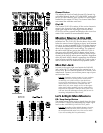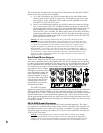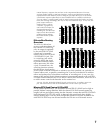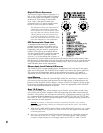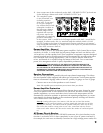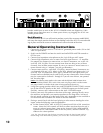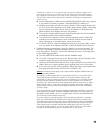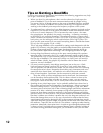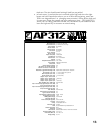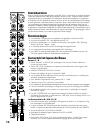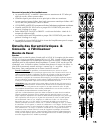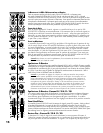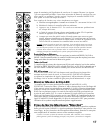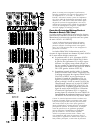
11
channels 9-10 and/or 11-12 as separate inputs perhaps for additional (high Z) mics,
instruments or other sources. In this situation, the channel BAL control will regulate
the comparative volume levels of any two sources coming into one of these channels.
The level fader MON, EFXand EQ controls would then be adjusted to regulate both
sources at once
b) Set the MAIN faders at 0dB, turn the MONITOR MASTER control up to approx.
8, the MAIN EFX master to around 7 and MONITOR EFX master to 5.
c) With the level faders still off, turn up the channel GAIN controls slowly until
the CLIP LED’s down beside the level faders begin to flash slightly. Now bring
up the channel level faders slowly until each channel can be heard at the
desired volume level through the main PA speakers
d) Turn up the channel MON controls until the performers can hear themselves
at adequate volume levels without feedback..
e) Turn up the EFX controls on those channels requiring reverb. Usually this
would be the lead and harmony vocal channels. Reverb may be used on
other channels or on recorded music, but at lower levels
f) Set the EFX SELECT control to establish the basic type of reverb, delay or what-
ever you prefer, then adjust the MODIFY control to establish the final sound.
9. Feedback during a performance is usually caused by one of the monitors. The
main PA is less likely to feed back because the mics are so far away from the
main PA speakers. Therefore, if one of the monitors and a mic are feeding back,
try the following procedures:
a) Turn the MONITOR master down until the feedback stops.
b) Go to EQ 2 and pull down one or two (but not more) of the EQ sliders in the
frequency range where the sound seems to be occurring
c) Now turn the MONITOR master back up. If the feedback recurs, push the EQ
slider/s back up to center position and try pulling down one or two others.
d) In the rare case of main system feedback, follow the above type of procedure,
but using the MAIN master and the built in GRAPHIC EQ.
Note B: The following notes apply to the system with the EQ/AMP ASSIGN button up
in the stereo L&R positionn.
(Everything is as above under Note A except that the main mix is now stereo which
means that the PAN and BALance controls can be used to position sources in the
sound field. Try NOT to postion sources (voices, instruments, etc.) too far left or right
however, because audience members near the “wrong” speakers won’t be able to
hear them. Also, EQ1 and EQ2 are both regulating the main PA sound now, so adjust
them similarly. Later on it may become necessary to adjust one of them slightly dif-
ferently because room acoustics have changed on that side of the room with people
coming or going
If you are employing a separate power amplifier for the monitor speakers, connect the
main speakers to the AMP 1 and AMP 2 SPEAKER OUTPUTS as in 6. above (also see
SPEAKER CONNECTIONS). Now run a shielded patch cord from the MONITOR OUT
jack to the input of the monitor power amp.
If you are employing a graphic equalizer for the monitors (a good idea - remember
there is no channel-EQ on the monitor signals and the AP312’s EQ 1 and EQ 2 are
now dedicated to the main-PA sound), run a shielded patch cord from the MONITOR
OUT jack to the input of the EQ, then another one from the EQ’s output to the input
of the monitor power amp (the Yorkville Beta-150EQ power amp has an EQ buil-
in). Follow the above steps in 7. and 8. to get the system ready to run. Now, take a
moment to read the following tips on running the this, or any, system.



